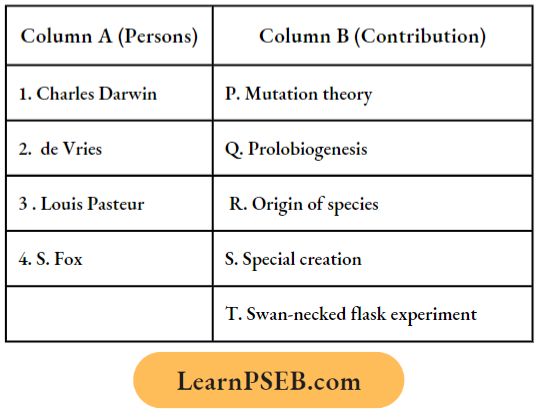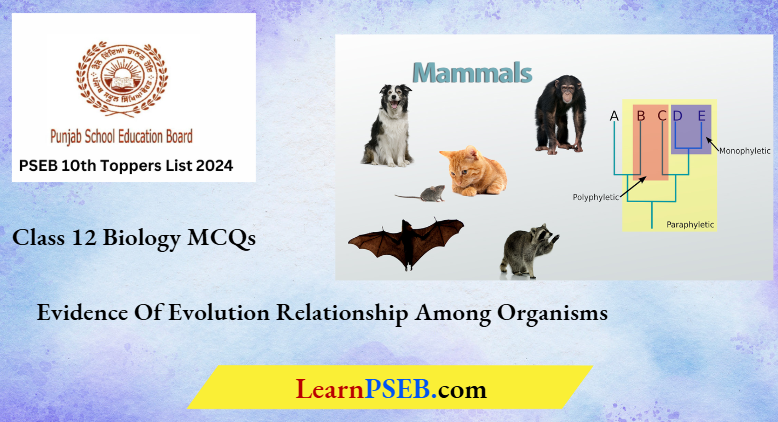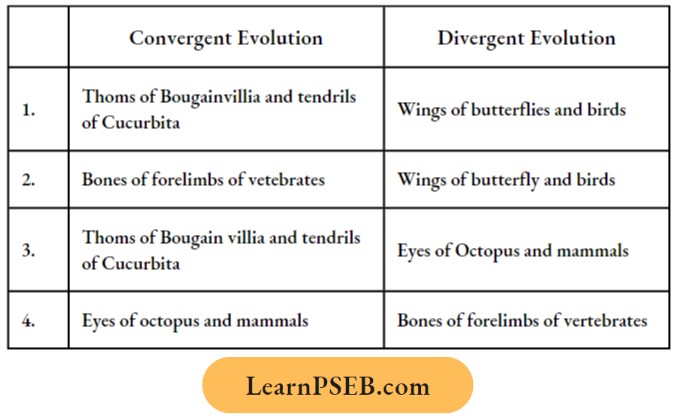Evidence Of Evolution Relationship Among Organisms Question and Answers
Question 1. Match the names of the persons listed under Column A with the contributions given in Column B; choose the choice which gives the correct combination of the alphabet:

- 1 = r, 2 = t, 3 = p, 4 = q.
- 1 = t, 2 = r, 3 = q,4 = p.
- 1 = p, 2 = q, 3 = r, 4 = s.
- 1 = r, 2 = p, 3 = t, 4 = q.
Answer: 4. 1 = r, 2 = p, 3 = t, 4 = q.
Read and Learn More 12th Class Biology MCQs
Question 2. Which one is not vestigial in humans?
- Third molar
- Coccyx
- Segmental abdominal muscles
- Finger nails.
Answer: 4. Fingernails.
Question 3. Coal has been mainly formed by:
- Bryophytes
- Pteridophytes/pteridosperms
- Angiosperms
- Algae.
Answer: 2. Pteridophytes/pteridosperms
PSEB 12th Class Biology Evidence of Evolution MCQs
Question 4. Darwin’s finches provide evidence of evolution from:
- Anatomy
- Morphology
- Biogeography
- All the above.
Answer: 3. Biogeography
Question 5. The vestigial pelvic girdle and bone remnants of hind limbs are characteristic of:
- Whale
- Dolphin
- Shark
- Seal.
Answer: 1. Whale

Question 6. Monkeys and some lower groups have certain blood groups which are:
- Identical to those of man
- Identical to those of anthropoid apes
- Somewhat similar to white persons
- Not identical to those of man.
Answer: 1. Identical to those of man
Question 7. The heart is four-chambered in:
- Amphibia
- Fishes
- Mammals
- Reptiles.
Answer: 3. Mammals
Question 8. A living organism with the oldest fossil history is:
- Dinosaur
- Archaeopteryx
- Horse
- Man.
Answer: 3. Horse
Question 9. Homologous organs are:
- Human eyes and Squid eyes
- Gills of Fish and lungs of Man.
- Hands of Man and Wings of Bat
- Leaf of Moss and a frond of Fern.
Answer: 3. Hands of Man and wings of Bat
Question 10. The occurrence of endemic species in South America and Australia is due to
- These species have been extinct in other regions
- Continental separation
- There is no terrestrial route to these places
- Retrogressive evolution.
Answer: 2. Continental separation
Evidence of Evolution Relationship Among Organisms MCQs PSEB Class 12
Question 11. Similarities in organisms with different genotypes indicates:
- Microevolution
- Macroevolution
- Convergent evolution
- Divergent evolution
Answer: 2. Macroevolution
Question 12. Convergent evolution is illustrated by:
- Dogfish and whale
- Rat and dog
- Bacterium and protozoan
- Starfish and cuttlefish.
Answer: 1. Dogfish and whale
Question 13. Which one of the following is categorized under living fossils?
- Metasequoia
- Ficus
- Cycas
- Selaginella.
Answer: 3. Cycas
Question 14. In which branch do we study about remains of plant life?
- Palaeontology
- Palaeobotany
- Eugenics
- Palynology.
Answer: 2. Palaeobotany
Question 15. Flippers of the seal are modified:
- Hind limbs
- Forelimbs
- Fins
- Gills.
Answer: 2. Forelimbs
Question 16. A baby was born with a small tail. It is a case of exhibiting:
- Retrogressive evolution
- Atavism
- Mutation
- Metamorphosis.
Answer: 2. Atavism
Question 17. Which of the following is a living fossil?
- Saccharomyces
- Spirogyra
- Cycas
- Moss.
Answer: 3. Cycas
Question 18. The age of fossils in the past was determined by the radioactive carbon method and other methods involving radioactive elements found in the rocks. More precise methods, which were used recently and led to the revision of evolutionary periods from different groups of organisms:
- Electron spin resonance and fossil DNA
- Study of carbohydrates/proteins in the rocks
- Study of carbohydrates/proteins in the fossils
- Study of conditions of fossilization.
Answer: 1. Electron spin resonance and fossil DNA
Class 12 Biology Chapter Evidence of Evolution MCQs
Question 19. Potato and sweet potato have edible parts which are:
- Analogous
- Homologous
- Recent introductions
- Two species of the same genus.
Answer: 1. Analogous
Question 20. Which of the following is not a vestigial organ in humans?
- Ear pinna muscles
- Nictitating membrane
- Mammary glands in males
- Knee bone.
Answer: 4. Knee bone.
Question 21. Trilobites evolved during:
- Silurian
- Cambrian
- Precambrian
- Devonian.
Answer: 2. Cambrian
Question 22. Which of the following is not vestigial in humans?
- Coccyx
- Nail
- Third molar
- Segmental muscles of the abdomen.
Answer: 2. Nail
Question 23. Which of these pairs is vestigial?
- Coccyx and car pinna muscles
- Coccyx ana premolar
- Facial hair in ladies
- Coccyx and intercostal muslces.
Answer: 1. Cococyx and car pinna muscles
Class 12 Biology Chapter Evidence of Evolution MCQs
Question 24. Which of the following points towards common ancestry?
- Eye of octopus and of mammal
- Vertibsate hearts
- Atavism
- All of above
Answer: 4. All of the above
Question 25. The eyes of the octopus and the eyes of the cat show different patterns of structure, yet they perform similar functions. This is an example of:
- Analogous organs that have evolved due to convergent evolution
- Homologous organs that have evolved due to divergent evolution.
- Analogous organs that have evolved due to divergent evolution.
- Homologous organs that have evolved due to convergent evolution.
Answer: 1. Analogous organs that have evolved due to convergent evolution
Question 26. Which of the following is the relatively most accurate method for dating of fossils?
- Uranium-lead method
- Potassium-argon method
- Electron-spin resonance method
- Radiocarbon method.
Answer: 3. Electron-spin resonance method
Question 27. The evolutionary history of an organism is known as:
- Palaeontology
- Ontogeny
- Phylogeny
- Ancestry.
Answer: 3. Phylogeny
Question 28. Which one of the following is not a living fossil?
- Archaeopteryx
- King crab
- Peripatus
- Sphenodon.
Answer: 1. Archaeopteryx
Question 29. An important evidence in favour of organic evolution is the occurrence of:
- Homologous organs only
- Homologous and analogous organs
- Analogous and vestigial organs
- Homologous and vestigial organs.
Answer: 2. Homologous and analogous organs
Question 30. The age of fossils or dating of fossils can be best estimated by:
- Radioactive carbon (C14) dating method
- Radioactive clock method
- Potassium-argon method
- None of the above.
Answer: 1. Radioactive carbon (C14) dating method
PSEB 12th Class Biology Evolution MCQs with Answers
Question 31. The example which best explains the atavism is:
- Nictitating membrane
- Wisdom teeth
- Vermiform appendix
- Long thick and dense hair.
Answer: 4. Long thick and dense hair.
Question 32. Which of the following gives the correct evidence from the connecting link?
- Ornithorhynchus — Between Amphibia and Reptiles
- Baltuwglossus — Between Protozoa and Porifera
- Neopilinct — Between MolluscaandEchinodcrmata
- Peripatus — Between Annelida and Arthropoda.
Answer: 4. Peripatus — Between Annelida and Arthropoda.
Question 33. Jurassic period of the Mesozoic era is characterised by
- Dinosaurs become extinct and angiosperms appear
- Flowering plants and the first dinosaurs appear
- Gymnosperms arc dominant plants and the first birds appear
- Radiation of reptiles and origin of mammal-like reptiles.
Answer: 3. Gymnosperms arc dominant plants and the first birds appear
Question 34. Which one of the following statements is correct?
- There is no evidence of the existence of gills during embryogenesis of mammals
- All plant and animal cells are totipotent
- Ontogeny repeats phylogeny
- Stem cells are specialized cells.
Answer: 3. Ontogeny repeats phylogeny
Question 35. The Finches of Galapagos islands provide an evidence in favour of:
- Evolution due to Mutation
- Retrogressive Evolution
- Biogeographical Evolution
- Special Creation.
Answer: 3. Biogeographical Evolution
Question 36. When two species of different genealogy come to resemble each other as a result of adaptation, the phenomenon is termed:
- Microevolution
- Co-evolution
- Convergent evolution
- Divergent evolution
Answer: 3. Convergent evolution
Question 37. Myrmecobius and Myrmecophaga are closely related and have similar adaptations for the same habitat. This phenomenon is
- Homoplasy
- Parallel evolution
- Divergent evolution
- Convergent evolution.
Answer: 2. Parallel evolution
PSEB 12th Class Biology Evolution MCQs with Answers
Question 38. Which one of the following options gives one correct example of convergent evolution and divergent evolution?

Answer: 4
